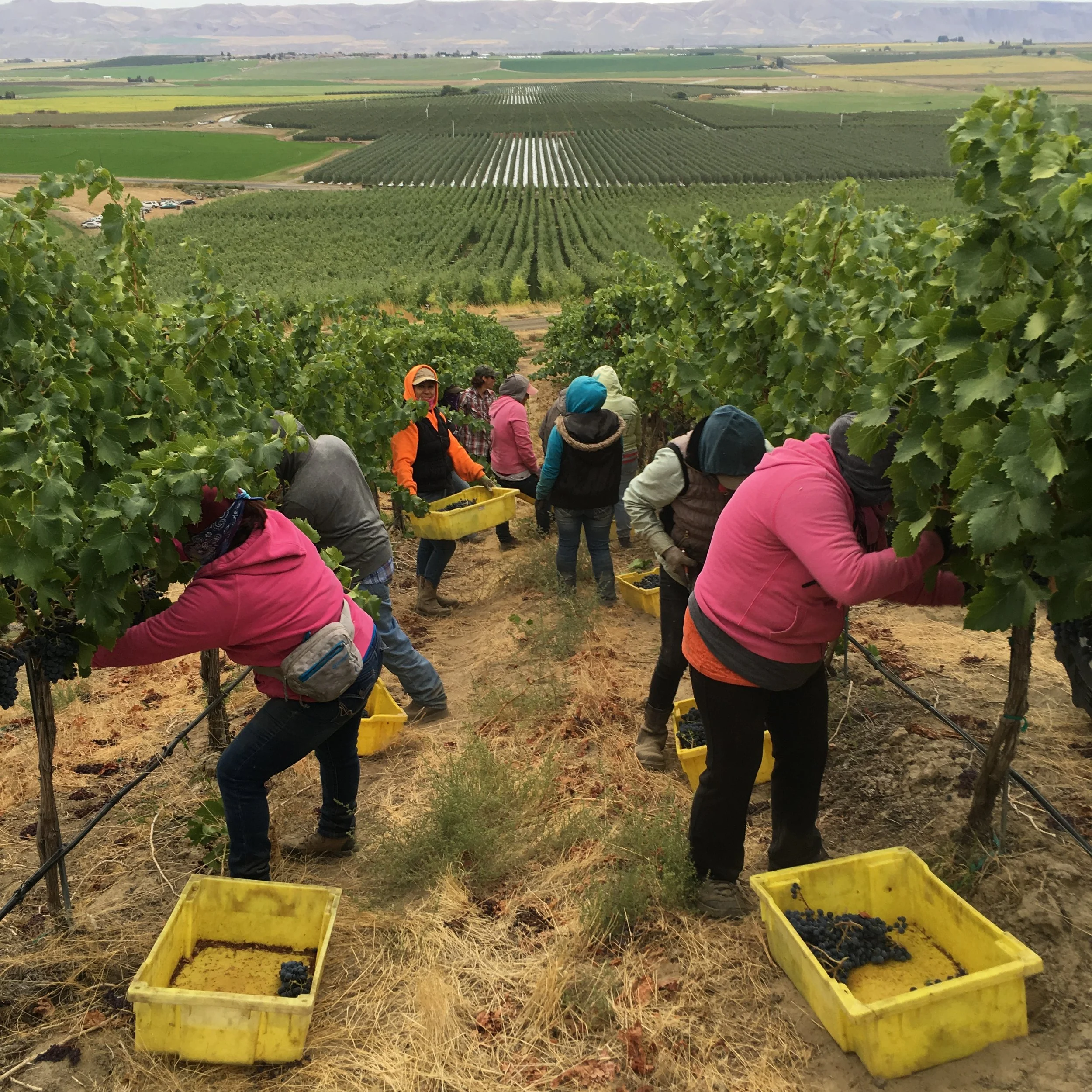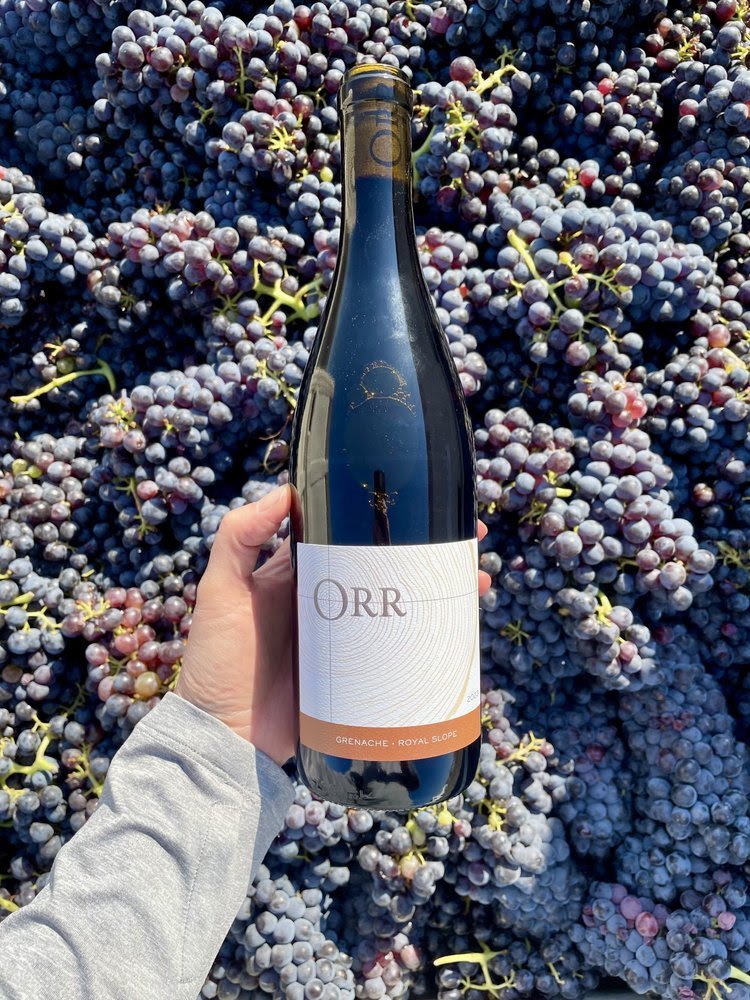How It's Made: Orr Grenache
We destemmed my first lot of 2025 Royal Slope Grenache (!) which got me thinking it’s a good time to share how it’s made.
Harvest Decisions
The winemaker’s choice of vineyard is the most important driver of wine style. The varietal, clone, vine age, farming method, slope, aspect, soil type and microclimate are huge. Second most important is the date of harvest.
The level of ripeness impacts wine flavors and balance. Grenache ripens unlike any other varietal I work with. Starting in August, the Grenache grapes slowly and asynchronously turn from opaque green to translucent light pink to dark purple during the maturation process known as veraison. This is in contrast to veraison in Cabernet Sauvignon vineyards which uniformly turn from green to blue-purple over the course of a couple days. And on the same Grenache vine there can be wholly purple clusters right next to clusters that are cuckoo multicolored. The vines look like this for weeks. This makes calling the pick real challenging … If I wait until all the clusters are totally purple, sugars are too high for my style,, and I’ve missed the pick. But the berries that haven’t fully colored up taste “green” and tart and unripe so I don’t want to make wine out of those either. Imagine Dominic Toretto threading the needle in his Dodge Charger in Fast and Furious but more like in terms of calling a Grenache pick.
On the Royal Slope in Washington state, the Grenache tends to be “high-toned” and bright and shows more “crunchy red fruit” like cran-raspberry pomegranate flavors. In other parts of the Columbia Valley, the Grenache can be meatier and more plush with darker fruit character like huckleberry and plum.
I’m working with two Royal Slope Vineyards- Stillwater Creek planted in 2004 and Lawrence Vineyard Corfu Crossing planted in 2008.
Stillwater Grenache below in July, August and on September 18, 2025
Destemmed Whole Berry Fermentations
Completely destemming and fermenting whole berries in my opinion is the best technique to achieve the bright crunchy red fruit thing which I am leaning into stylistically with my Royal Slope Grenache.
Other winemakers prefer some whole clusters in their Grenache ferments - best case scenario the grape stem (technically called rachis) adds a black tea earthy complexity, worst case it brings a green banana peel, unripe astringency.
Punchdowns Vs Pumpovers
I add sulfur dioxide at the destemmer to inhibit wild bacteria and spoilage organisms and after I pull a sample to run a juice panel for Brix, TA, pH, malic, and yeast assimilable nitrogen in the lab, I inoculate the must with a commercial freeze dried strain of yeast that was isolated from a winery and then propagated and sold. My ferment takes place inside of an open top bin that holds about 1.25 tons. I like to punchdown once or twice a day for the 11 or 12 days the wine is on skins. Imagine a French press coffee.
There are other ways to mix a fermentation and encourage the extraction of color and tannins from the skins into the juice (pumpover, rack and return, foot stomping, pulsair blast) but for me punchdowns are the best from a mixing and extractive standpoint. When it is time to press off, we pump the free run wine out of the fermenters into a tank and load the skins into the press. I blend my Grenache press wine together with the free run in tank and settle it overnight and then we barrel down into my old “experienced” oak barrels.
When the residual sugar is low enough to indicate that primary fermentation is complete, I inoculate for malolactic in barrel using a freeze-dried bacterial strain. Malo takes about 6-8 weeks and then I add SO2, top and hard bung before the new year.
The shimmery glimmery phenomenon
This low-resolution video above shows the glittery sparkle that I see in the new wine in like January February after vintage. Fermentation is over, the wine is like sorting itself out. Mythbusters: I think what’s happening is that the solubility of potassium bitartrate is lower in wine (a 14% alcohol solution) compared to the sugar water solution of grape juice it started in, so the salt precipitates out. The cellar is cold in winter, and I think that crystals of potassium bitartrate form and are suspended by CO2 and then magically float around all shimmery glimmery? By springtime, it has precipitated out and the wine is translucent and clear. But it sure is fun to swirl around in my wine glass in winter.
I feel like this would make a great nail polish. Why aren’t nail polishes named after wines? I’ll take a Rayas pedi please and thank you.
Bottling
Deciding precisely when to bottle is a whole thing - my Grenache style is very fresh, very primary and I can capture that fruitiness if I bottle during the summer after vintage. My red wines are unfined and unfiltered, so I aim to do a very clean racking (that’s me holding the flashlight against the sightglass above) but if some of the lees come into the bottling tank, sobeit. It is what it is. So the last pour from a bottle of my wine has some sediment or haziness … I’m ok with this and I hope you are too. The wine was obviously minimally handled.
There’s a zillion things that can go wrong as we move the wine from tank into bottle and my goal is always for a no drama bottling event. Boring is beautiful.
Aging
I wouldn’t release my wines if I didn’t think they were ready to go. Personally, I like the freshness of young wine. My recommendation is drink now but if you prefer to cellar them - go ahead!






